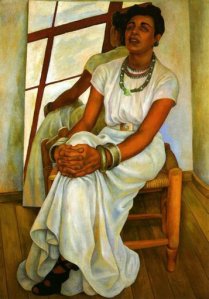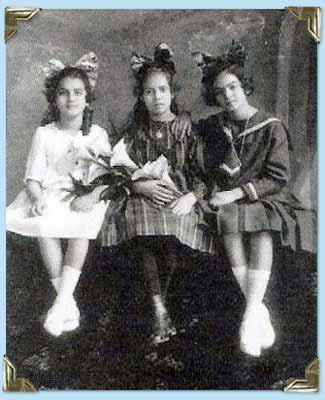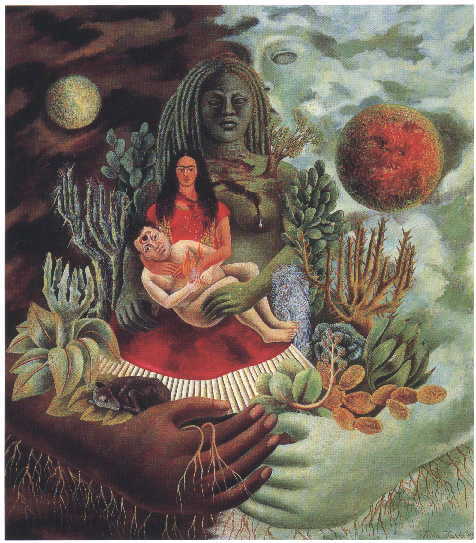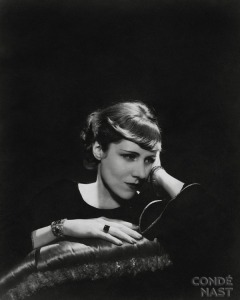
Diego Rivera, seated in front of a mural depicting the American class struggle, 1933.
Frida Kahlo (1907-1954) went into her marriage (1929) with her eyes wide open. She knew that her husband, famed Mexican muralist Diego Rivera, spread his affections around. Diego engaged in numerous short-lived and casual relationships with the fawning women – actresses, models, artists, photographers – who flocked around him. He was Mexico‘s most celebrated artist of his time.

"Portrait of Lupe Marin," by Diego Rivera, 1938
Diego’s many extramarital affairs had destroyed his previous marriage to Lupe Marín, Once, in front of a group of guests, a jealous Lupe made quite a scene, tearing a rival’s hair, ripping up some of Diego’s drawings, and beating Diego with her fists. Another time she smashed some of his archaeological artifacts and served the broken shards to Diego in a soup bowl.
At the beginning of their marriage, whenever Frida learned of yet another of Diego’s affairs, she managed to put on a good face. She pretended it did not hurt her, excusing Diego by saying flippantly, “How would I be able to love someone who wasn’t attractive to other women?” She retaliated by having love affairs of her own, with men and with women, once telling acquaintance Jean van Heijenoort that her view of life was
Make love, take a bath, make love again.”
She held up until the year 1934. That was the year Frida and Diego returned from living three years in the United States. Their funds were low. Diego’s Rockefeller Center mural had caused a terrible controversy. Diego had painted a heroic portrait of the Russian Communist leader Vladimir Lenin in the mural and had refused to paint him out. Diego was fired and the mural was then destroyed. Homesick for Mexico, Frida made Diego return home, against his wishes. Diego sulked.

"Portrait of My Sister Cristina Kahlo," by Frida Kahlo, 1928 (portion)
Demoralized and broke, both of them were also in poor health. Diego had maintained a grueling painting schedule on the scaffold, turning out murals in San Francisco, Detroit, and New York, and was “weak, thin, yellow, and morally exhausted,” Frida wrote to her friend Ella Wolfe that July. Frida had been in the hospital three times that year – for an appendectomy, a therapeutic abortion, and foot surgery.
No one knows exactly when Diego began his affair with Frida’s sister Cristina; it was probably in the summer of 1934. Frida was devastated. Cristina was not just her sister but her confidante. Cristina’s husband had left her in 1930 and, since then, she and her children had spent a great deal of time at Frida and Diego’s house. Cristina had served as a model many times for Diego’s murals and they had grown very close, too close, to Frida’s chagrin. Diego had, no doubt, seduced Cristina with his clever words, and convinced her that he needed her, reminding Cristina that Frida was too sick for lovemaking and that he, Diego, was sad and needy.

"Self-Portrait with Curly Hair," by Frida Kahlo, 1935
In her great anguish, Frida cut off her long hair and stopped wearing the native Mexican costumes that were her signature look and that made Diego so happy. She painted a self-portrait of her new look. This little painting, 7-1/4 x 5-3/4 inches, was called “Self-Portrait with Curly Hair.” Her smallest canvas ever, Frida gave the little painting to Ella Wolfe, Frida’s longtime friend and the wife of Diego Rivera’s biographer, Bertram Wolfe. Ella kept the painting until 2000. In 2003, “Self-Portrait with Curly Hair” was auctioned off by Artemundi & Co. and sold for $1,351,500.00. Today, Frida Kahlo remains the most expensive-selling female artist in the history of art.
During that period of terrible pain from the betrayal by both husband and sister, Frida painted another painting quite different from “Self-Portrait with Curly Hair.” This one was morbid, bloody, disquieting. Shown below, “A Few Small Nips” features a woman being literally “murdered by life,” as Frida herself felt, murdered both physically by her chronic pain and suffering and emotionally by Diego and Cristina. The painting’s theme is based on a newspaper account of a real murder. A drunken guy threw his girlfriend on a cot and stabbed her 20 times. When interviewed, the brutal murderer protested his innocence, saying, “But I only gave her a few small nips.”

"A Few Small Nips" by Frida Kahlo, 1935.
NEXT: Frida to Diego: I Can’t Live, if Living is Without You!
Readers: For more on Frida Kahlo on this blog, click here.
Read Full Post »





















































